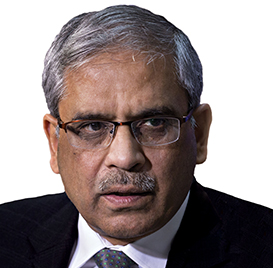It would be an understatement to say that the governor of the State Bank of Pakistan (SBP), the country's central bank, has his hands full. Trade and budget deficits are ballooning, foreign currency reserves are shrinking, and a return to the hands of the International Monetary Fund (IMF) seems imminent. Yet Tariq Bajwa, in his post since July 2017, presents a calm exterior.
In May, the independent Monetary Policy Committee, chaired by Mr Bajwa, raised Pakistan's main policy rate by 50 basis points (bps) to 6.5%. This followed a 25bps hike in January, up from a 44-year low of 5.75%. The latest double-jump partly reflected the build-up of inflationary pressures, including increased petrol prices, which are set every month by the government. Core (non-food, non-energy) inflation rose from 5.7% in January to 7.2% at the end of May.
Headline inflation, however, benefited from low to zero food inflation, and averaged only 3.8% for the first 10 months of the financial year ending in June 2018. The bank expects the full-year average to remain within its model range of 3.5% to 4.5%, though the financial year 2019 figure may be marginally above the SBP’s 6% annual target. “The critical reason [for the hike] was the twin deficit,” acknowledges Mr Bajwa, previously the senior civil servant at the ministry of finance and well regarded by bankers.
External deficit
The central bank’s forecast range for the financial year 2018 fiscal deficit is 5% to 6% of gross domestic product (GDP) (it was 5.8% for financial year 2017). Bilal Khan, Standard Chartered Bank’s senior economist Middle East, North Africa and Pakistan, expects it to reach 6.5%. The shortfall is mainly the result of heroically unsuccessful tax collection.
It is the external deficit that threatens to really rock the boat in the short term. The China-Pakistan Economic Corridor has caused a surge in imports, while exports have suffered from global headwinds, low commodity prices and an overvalued rupee. Foreign liabilities have risen to a reported $92bn, with hard currency debt repayments growing accordingly.
Exports have picked up in financial year 2018 and import growth is slowing, but the current account deficit worsened from $9.4bn in the first 10 months of financial year 2017 to a record $14bn for the same period in financial year 2018. The external deficit for the full year could be up to 5% of GDP (it was 4.1% for financial year 2017), according to the SBP. Mr Khan has pencilled in 5.3%.
This has taken its toll on the SBP’s foreign currency reserves, which ended financial year 2017 at $16.1bn but, by May 25, 2018, were down to $10bn, about two months’ worth of imports. “We want them to be higher, but we have current account pressures,” says Mr Bajwa. “We have demonstrated that we are willing to use all the tools at our disposal – adjusting the currency, monetary policy. Since December we have moved boldly in both, and we will continue to be nimble in our use of policy instruments.”
The rupee has devalued against other currencies by 9.5% since December. The SBP has been borrowing hard currency from foreign commercial banks, notably Chinese lenders, who lent it another $1bn in April.
If we have to go back to the IMF, we will go back. I don’t see any opprobrium attached
Hard currency strategy
“The government is aware of the strains, and has been in touch with multilateral institutions such as the World Bank and the Asian Development Bank,” says Mr Bajwa. “There are projects in the pipeline which will see positive hard currency inflows to Pakistan.” The Islamic Development Bank has reportedly agreed to lend Pakistan $3.285bn.
A new government may choose to return to the capital markets to sell more international bonds. The sovereign raised $2.5bn in November 2017 with a five-year sukuk and a 10-year conventional bond.
Hard currency remittances from expatriate Pakistanis, many working in the Gulf, have been a traditional mainstay. They fell in 2017 by 3% to $19.4bn, but have made up that lost ground in 2018. “We expect remittances to bounce back,” says Mr Bajwa.
None of this is likely to prevent the need for a more substantial bailout. If Pakistan returns to the IMF, it will be for the 13th time in three decades. Mr Bajwa is not dismayed. “If we have to go back to the IMF, we will go back,” he says. “I don't see any opprobrium attached. We did a very successful programme last time.”
The governor sees these as temporary setbacks. Current account difficulties will have to be managed over the next couple of years, he agrees, “but I am confident that, as exports continue to grow, they will narrow the gap with imports, which are decelerating even now”.












